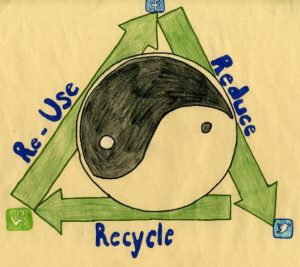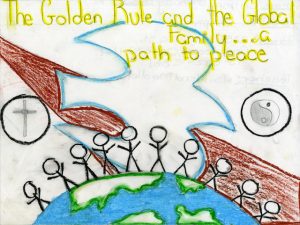9.3 Lesson Two – The circles in our lives
Time required: 60 minutes
Materials required: chart paper, marker pens, art utensils, art paper, Scarboro Missions Golden Rule Poster (large and/or small size)
Teacher instructions:
In this lesson, the students continue to reflect on the meaning of circles in their lives and on the students’ relationship with the Earth, as well as with other human beings in our global village.
The teacher begins by reviewing the previous lessons and refocusing on the Golden Rule Poster. The teacher may wish to stimulate discussion about the students’ reflections in the previous lesson (Lesson One) that were recorded on chart paper. The teacher then poses more questions to the students for feedback and discussion. Here are some suggested trigger questions:
- How do the circles and the pattern of circles on the Golden Rule Poster speak to you about the deeper meaning of the Golden Rule:
- In your personal life?
- In your friendships?
- In your life as a student?
- In your home life?
- In your relationship to the local community?
- In your relationship to the international community?
- In your relationship to the physical environment?
- Today, we are seated in a circle. Can you make any connections between the following four points?
- The fact that we are seated in a circle
- What you have learned about circles
- The role and meaning of circles in the design of the Golden Rule Poster
- The deeper meaning of the Golden Rule for your personal life and for your relationships with other human beings and with the physical environment.
(This question would, of course, be relevant only to classes who are using a circular seating arrangement.)
- Is the Golden Rule just a guideline for how one person should treat another person? Or, can the golden rule be a guideline for how one group of people treats another group of people? For example, how one family can treat other families? How one culture can treat other cultures? How one ethnic group can treat other ethnic groups? How one nation can treat other nations? Explain. Do you think that the circle is a symbol of equality, unity, reciprocity and interconnectedness? If yes, do you believe that these symbolic qualities of the circle are important in terms of how the Golden Rule can or should be applied between and among groups? Explain.
- Dr. Harry Gensler is a professor of philosophy and ethics in the United States. He is also an expert on the Golden Rule. Here are his thoughts on President John F. Kennedy’s suggestions for applying the Golden Rule: “President Kennedy in 1963 appealed to the golden rule in an anti-segregation speech at the time of the first black enrollment at the University of Alabama. He asked whites to consider what it would be like to be treated as second-class citizens because of skin color. Whites were to imagine themselves being black – and being told that they couldn’t vote, or go to the best public schools, or eat at most public restaurants, or sit in the front of the bus. Would whites be content to be treated that way? He was sure that they wouldn’t – and yet this is how they treated others. He said the ‘heart of the question is … whether we are going to treat our fellow Americans as we want to be treated.’ ” What is your reaction to President Kennedy’s approach to the Golden Rule? Explain. If you agree that the circle is a symbol of equality, unity, reciprocity and interconnectedness, do you see some qualities of the circle in President Kennedy’s suggestions as to how we should treat one another? Explain.
- Do you ever think of yourself as a “global citizen” – as a person who is more than just a citizen of a rural area, a town, a city or a country, but rather as a person who belongs to the international community of people, a person who belongs to one, single, interacting, global human family? If you see yourself as an international citizen, how does the Golden Rule Poster – its design, its circles and its 13 “rules” – speak to you as a global citizen?
- Were you born in another country? Or, have you lived in or visited another country (or countries)? If your answer to one or both of these questions is “yes”, have these experiences caused you to see yourself as a “global citizen” – as a person who is more than just a citizen of a rural area, a town, a city or a country, but rather as a person who belongs to the international community of people, a person who belongs to one, single, interacting, global, human family? If you see yourself as an international citizen, how does the Golden Rule Poster – its design, its circles and its 13 “rules” – speak to you as a global citizen?
- “We should act toward other nations as we wish them to act toward us.” These words were spoken by Millard Fillmore (1800-1874), the thirteenth president of the United States. Do you see this statement by President Fillmore as another way of expressing the Golden Rule? Explain. Do you believe that it is possible for one nation to treat other nations as it would like to be treated? Explain. If you agree that the circle is a symbol of equality, unity, reciprocity and interconnectedness, do you see some qualities of the circle in President Fillmore’s suggestion as to how the Golden Rule can or should be applied between and among nations? Explain.
- Mussie Hailu, who lives in Ethiopia, Africa, is committed to taking the message of the Golden Rule to the four corners of the earth. Mr. Hailu travels to many parts of the world to help people understand how the Golden Rule contributes to peace, social justice and a healthy environment. He has established April 5 as International Golden Rule Day. Do you have any ideas about what people around the world could do to celebrate this annual Golden Rule Day? Explain. Do you see a connection between an International Golden Rule Day and the design of the Golden Rule Poster? Explain.
- When you look at the Golden Rule Poster, can you think of some ways that we as individuals in our local community can encourage other people around the world to practice the Golden Rule?
- Throughout these lessons,
- What have you learned about rules?
- What have you learned about circles?
- What have you learned about the Golden Rule?
- What have you learned about the design of the Golden Rule Poster, including the fact that the whole world – in the form of a globe – sits in the centre of the poster with the words “The Golden Rule” imposed on it? What does it mean to you that the globe is a circle, surrounded by a circle of circles, and 13 different statements of the Golden Rule?
- What would the world be like if all the people on our planet lived their lives according to the Golden Rule? Does the Golden Rule Poster – its overall design, its circles and its 13 “rules” – symbolize, for you, a world in which the Golden Rule “rules”? Explain.
Art activity
The teacher makes the Black Elk statement and its introduction (see box below) available to the students by way of the blackboard or chart paper or as a handout. This statement could also be given to the students as a handout prior to the class.
The circle is a central symbol in the Native American way of life. The circle pervades most aspects of Native thought and life, because it represents a vital connection between the individual, the community, and the entire physical environment. This vitality is captured rather well by the following statement from Black Elk (1863-1950), a Sioux/Lakota elder (of the Plains Indians of North America):
“The universe is circles within circles, and everything is one circle, and all the circles are connected to each other. Each family is a circle, and those family circles connect together and make a community, and the community makes its circle where it lives on the Earth. It [the community] cares for that part [of the Earth] but cares for it as a circle – which is to say in a co-operative and egalitarian way, where everybody is cared for, and everybody is respected.”
After the students have read Black Elk’s words, and after a class discussion about his statement, each student is provided with a blank piece of paper (suggested size: 18 x 24 inches.)
Working with a guiding question such as “Is your life a circle?” or “Are there circles in your life?”, the students are invited to depict the place of circles in their lives. In their artwork, the students are encouraged to include various facets of their lives, including, for example, home, friends, sports, school, hobbies, nature and the larger community, including the international community.
When the artwork is completed, some students are asked to display and explain their art. This is followed by discussion.
Homework assignment
The students are assigned to research an organization or project that promotes an awareness of and a commitment to global citizenship. The teacher can decide whether the students will present the results of their research in the form of a reflection paper or an in-class presentation.
In their research, the students are invited to explore how the chosen organization or project embodies an international application of the Golden Rule. The students may also want to investigate if and how the work of the organization or project reflects the symbolic, written and visual features of the Golden Rule Poster.
For the consideration of the teacher, here follows a list of suggested organizations and projects that have a global focus and touch on various themes including social justice, multiculturalism, youth, equity, diversity, global citizenship, peace-making, humanitarian service, cross-cultural relations, ecological sustainability, and disaster relief:
Charter for Compassion
Clowns Without Borders
Doctors Without Borders
Engineers Without Borders
Free the Children
From Me to We
Gesundheit Institute
Global Ethic Foundation
Global Poverty Project (Australia)
Global Youth Network
Habitat for Humanity
Interfaith Youth Core
Kids4Peace
Kiva
Peaceful Schools International
Physicians for Peace
Red Cross
Taking it Global
Teachers Without Borders
UN Millenium Development Goals
UNESCO
United Nations
United Network of Young Peacebuilders (UNOY)
United Religions Initiative
War Child
World Organization of the Scout Movement
World Spirit Youth Council
Worldwatch Institute
World Wildlife Foundation
.
All of the above projects and organizations have websites.
Journal activity: Let’s write about it!
For journal questions to stimulate the students’ written reflections after or during class, see Appendix 7.


